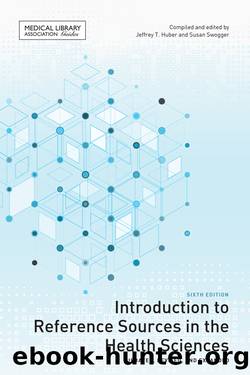Introduction to Reference Sources in the Health Sciences, Sixth Edition by Huber Jeffrey T.;Swogger Susan;

Author:Huber, Jeffrey T.;Swogger, Susan; [Huber, Jeffrey T.; Swogger, Susan]
Language: eng
Format: epub
Tags: MED078000 Medical / Public Health
ISBN: 9780838919576
Publisher: American Library Association
Published: 2014-05-21T00:00:00+00:00
The Physiciansâ Desk Reference (PDR) is an annual compilation of package inserts. The introduction to this drug chapter discusses FDA requirements regarding package inserts. The PDR does not just contain package inserts. In addition, âfor products that do not have official package circulars, PDR has asked manufacturers to provide comprehensive product information.â In fact, it is difficult to tell which entries are official package inserts and which are not. The information in the PDR is arranged by company name. Most of the products marketed in the United States are listed in the PDR, making it a handy and frequently requested source. The PDR is useful for drug dosage, composition, contraindications, warnings, use, and adverse effects. The indexes included in the front of the PDR are a manufacturersâ index, with addresses and contact information for most companies; a brand and generic name index; a product category index; and a product identification guide with color photographs of more than 1,600 tablets, capsules, and other dosage forms. Other resources to consider for visual drug identification are Drug Facts and Comparisons, Clinical Pharmacology, and Micromedexâs IDENTIDEX, all available online (see 10.12, 10.17, and 10.18). Since the PDR is a source of manufacturer disclaimers, cautions, precautions, and side effects are enumerated in great detail, although there is sometimes no indication of the severity or frequency of the side effects.
The earliest editions of the PDR carried the subtitle âfor the physicianâs desk only,â and volumes were distributed free to physicians as a marketing tool. However, with the recent consumer movement in health care, this statement has been removed, and the PDR is now for sale throughout the country in bookstores. Librarians should be concerned about the publicâs reliance on the PDR. First, the information is not necessarily unbiased but represents only what the FDA has approved the manufacturer to disclose. Second, the coverage is selective, as drug companies are charged for inclusion. Therefore, not all drug companies participate, and those that do typically only include their more profitable drugs. Third, librarians should understand that the information included about drug use is not necessarily complete. Physicians can legally prescribe drugs for therapeutic applications which have not yet been approved by the FDA, and these off-label uses will not generally be addressed in the PDR. Finally, the information in the PDR is written in technical language and may be difficult for the general public to understand. Because rare side effects are included, the work may prove unnecessarily frightening to the nonprofessional reader. An ongoing challenge for the health sciences librarian is to channel members of the public from the PDR to more appropriate sources.
The popularity and success of the PDR have caused a whole series of PDR books to appear. Some of these titles are worth listing here; others will be covered in the following sections. The PDR for Herbal Medicines is discussed in more detail in the âHerbal Medicines and Natural Productsâ section of this chapter (see 10.39). Two complementary PDR publications that librarians may consider are the PDR for Nonprescription Drugs and the PDR for Ophthalmic Medicines.
Download
This site does not store any files on its server. We only index and link to content provided by other sites. Please contact the content providers to delete copyright contents if any and email us, we'll remove relevant links or contents immediately.
Cecilia; Or, Memoirs of an Heiress — Volume 1 by Fanny Burney(32060)
Cecilia; Or, Memoirs of an Heiress — Volume 3 by Fanny Burney(31455)
Cecilia; Or, Memoirs of an Heiress — Volume 2 by Fanny Burney(31406)
The Great Music City by Andrea Baker(30780)
We're Going to Need More Wine by Gabrielle Union(18630)
All the Missing Girls by Megan Miranda(14722)
Pimp by Iceberg Slim(13777)
Bombshells: Glamour Girls of a Lifetime by Sullivan Steve(13683)
Fifty Shades Freed by E L James(12909)
Talking to Strangers by Malcolm Gladwell(12869)
Norse Mythology by Gaiman Neil(12823)
For the Love of Europe by Rick Steves(11450)
Crazy Rich Asians by Kevin Kwan(8886)
Mindhunter: Inside the FBI's Elite Serial Crime Unit by John E. Douglas & Mark Olshaker(8699)
The Lost Art of Listening by Michael P. Nichols(7159)
Enlightenment Now: The Case for Reason, Science, Humanism, and Progress by Steven Pinker(6871)
The Four Agreements by Don Miguel Ruiz(6313)
Bad Blood by John Carreyrou(6274)
Weapons of Math Destruction by Cathy O'Neil(5829)
